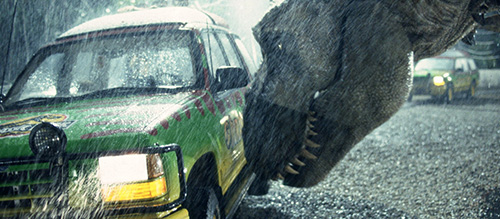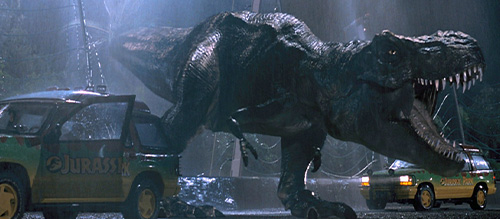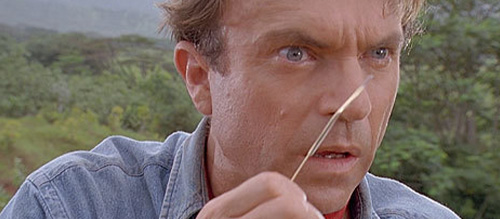Spielberg’s ‘Jurassic Park’ VFX Remain the Industry’s Gold Standard

We are living in a world of CGI dreamscapes, the kind of place where the randomness of any mistake can be “corrected in post” by a team of hundreds of artists and technicians working to bring every last element of the filmmaking process to life, whether it be on a Marvel movie or a David Fincher film. If Tom Holland’s fringe accidentally falls too close to his eye, there’ll be a team of people ready and willing to remove it. If David Fincher wants the perfect house but doesn’t have the time nor budget to build one as Bong Joon-ho did for Parasite, there’s a team of people ready and willing to create it.
Despite them being often maligned by cinephiles and critics, computer generated images have improved some aspects of cinema. An artist like the aforementioned David Fincher can construct the most accurate vision he hopes to construct, whilst Marvel can offer galaxy-spanning warfare on a level most could only ever have dreamt of in the past. CGI is in many ways encouraging fantastical creations, bringing the realms of imagination and reality closer together. If cinema was ever the “dream factory”, those of a particular stance could argue that Hollywood cinema is more about dreams than it ever has been. This is one key reason that the fantasy genre, through the medium of comic book adaptations, has exploded in the 21st century.
One filmmaker inexorably linked to the development of the current era’s rich palette of CGI-driven material is Steven Spielberg. A close friend of Industrial Light & Magic founder George Lucas (Star Wars), and a frequent collaborator with Lucas’ film studio Lucasfilm, Spielberg was quick to show off the quality of modern technology as early as his third theatrically released feature Close Encounters of the Third Kind (1977). That year, Close Encounters and Star Wars would be the only nominees for the Oscars’ Visual Effects category, Lucas’ revolutionary space opera taking home the award. From there, Spielberg and Lucas would partner on Indiana Jones, a series that relied more on computer generated images as each film was released, and Spielberg would heavily lean on CGI for his most fantastical moments in the decade to follow, particularly those found in E.T. the Extra-Terrestrial (1982) and Hook (1991).
“I think I’m extinct.”
In 1993, Steven Spielberg oversaw what is widely recognised to be one of the most important and influential real-world developments to CGI in history, the dinosaurs of Jurassic Park.
Universal and Spielberg’s Amblin partnered with George Lucas’ Industrial Light & Magic to put together CGI so astounding that it has become the stuff of legend. Followers of Jurassic Park, or the wider developments of cinema, will be able to tell you that upon seeing the CGI in action, iconic practical effects supervisor Phil Tippett famously declared “I think I’m extinct” (a line that was later worked into the film).
The sequence with the T-Rex in the rain is as close to photorealistic as we can still feasibly imagine, and as a result the creature’s impact has become one as closely tied to our cultural memory of cinema as Charles Chaplin’s The Tramp or Lucas’ Darth Vader; it is iconic. Without computer generated imagery, the T-Rex would not have been able to so convincingly chase down Dr Ian Malcolm (Jeff Goldblum), nor would it have looked quite so menacing as it did when it came rushing into shot during the film’s conclusive velociraptor hunt.
And still, these effects were pre-Titanic, pre-Pixar, before Spider-Man, years ahead of The Matrix. There had been some outstanding visual effects work in the decades prior to Jurassic Park – not least in the works of Ridley Scott and James Cameron – but Jurassic Park remains almost untouchable, the T-Rex as perfect a cinematic construction as any CGI concoction in history. The reason for its continued dominance isn’t because the technology has failed to develop, or the teams of people working on the CGI have grown worse at their jobs, it’s because the computer generated imagery was presented through the lens of the world’s greatest effects-driven director at the absolute height of his powers.

Originally, director Steven Spielberg had intended to put Jurassic Park together with as many practical effects as possible. By today’s standards you could argue that he succeeded, but in 1993 it was unheard of to balance a $60million-plus movie on the back of what was barely tested computer software, and almost every scene that captured the dinosaurs in full was reliant upon this technology and the few people who could accurately predict its effectiveness. Despite studio concerns, Spielberg’s utter amazement at his first glance at this technology is said to have inspired his stance, but heeding the advice of those above him and taking all his knowledge and inspiration from the practically staged films of prior eras (not least the Westerns of John Ford), the director embraced every element he could and moulded them to the filmmaking language of the greats.
He didn’t necessarily present the most detailed and rich CGI of all time, but Jurassic Park remains the gold standard of visual effects because Steven Spielberg made us do that which all filmmakers strive to do… believe.
There is so much to be said for the interest that Spielberg creates through the use of blocking (the movement of people and objects within a shot) in what is a surprisingly static movie for one so expensive and widely acknowledged to be a blockbuster. He uses it so effectively in small scenes of exposition or sequences aimed at enriching each of the characters, but it’s in the moments with the dinosaurs themselves that his expertise in this realm come to the fore, his sensational use of space in both the T-Rex and velociraptor hunts being iconic because of how he makes their presences entirely believable.
In the very first act, we see an animatronic velociraptor be born from its egg, Richard Attenborough’s John Hammond picking a broken piece of shell from the dinosaur’s head as it breaks free. Another director might have chosen to side on narrative logic in this instance, putting Hammond and company behind a glass case so as to not infect the dinosaur or disrupt the birth, but Spielberg chooses the greater truth: the truth of the viewer.
The above scene, and the one that comes soon after in which Sam Neill’s Alan Grant lays his body weight on a felled triceratops, are so strikingly realistic that you can’t help but to feel the awe that Grant and company are feeling themselves. These scenes are realistic partly because of the visual effects, yes, but more so because the characters themselves are interacting with them. These dinosaurs are a part of the same world that they are.
This, of course, comes to a crescendo when the tyrannosaurus rex breaks free of its cage.

The T-Rex here is presented via animatronic head in close-up, and via full CGI in wide shots, and it’s Spielberg’s dedication to detail that truly elevates this incredible debut to the highest of heights. First we see that the goat it has been fed is now missing, then we see the T-Rex’s claw pushing against the electric fence – we instantly recognise the very real impact that this gruesome dinosaur has had and seems destined to have. The setting has been so well designed, and Spielberg has so impressively got us acquainted with the space by going back-and-forth to conversations in each car, that when the T-Rex breaks free of its cage the resulting mesh of wire and concrete provides a lasting change to the environment – one that is ultimately the centrepiece of this sequence’s conclusion when Alan Grant, Lex (Ariana Richards) and Tim (Joseph Mazzello) are thrown down it. As the T-Rex moves, water begins to shake, not only effectively increasing the anticipation for what is a uniquely horror-adjacent blockbuster villain, but also reinforcing that this is a very real creature about to have very real consequences on the people we have so far become acquainted with. In the resulting carnage, the dinosaur eats one of the characters and nearly kills several more, but the genius of Spielberg’s work here comes in ensuring that the dinosaur can not only be heard and seen, but that the effects of its presence are felt within the movement of objects in the scene.
The pupil of the T-Rex’s eye constricts when light is shone in it, and the rain soaks it as it prowls around the car of the children. When it eventually goes mouth first into the sunroof of the vehicle, the two children are shown holding the plexiglass between their limbs and the ginormous teeth of the animatronic head. As the scene evolves, the T-Rex begins to spin one of the cars around when Tim has been trapped beneath it, leading to Alan and Lex having to repel down a cliff face. Then, the resulting chase of Doctor Ian Malcolm sees the dinosaur crush a tree branch that has fell onto the road.
We, as cinemagoers, know that the reality we’re being presented with isn’t real – that’s why we call the watching of a film “the suspension of disbelief” – but what Spielberg does better than anybody is acquaint you with the rules of the universe he’s presenting in the most entertaining and ultimately effective way possible. Jurassic Park is, like Jaws, a blockbuster horror film. The T-Rex is a monstrous villain of the ilk of Frankenstein’s Monster, while the velociraptors are Freddie Krueger-like psychopaths complete with gut-splitting apparatus. The dinosaurs therefore need to offer threat to the human characters, and to do so they must be a believable presence in their world. The ripples in the water, the constriction of the pupil, the spinning of the car, all help to enrich the believability of these creatures and their impact on the characters we have so far associated ourselves with. Every interaction these dinosaurs have leads to more believability, to more impressive visual effects.
Later in Jurassic Park, Wayne Knight’s Dennis Nedry is poisoned and eaten by a smaller dinosaur, the presence of this creature again not only being seen but being presented as having very real effects on the parts of the film’s world we can’t even question the reality of: the car and the human being. In the film’s conclusion, the velociraptor creates condensation when it breathes onto a window, it crashes head first into a shiny kitchen cabinet, and Spielberg focuses almost meticulously on these creatures being able to open doors, because a door handle is about as real and relatable to anyone watching this film as anything else it presents. Having a velociraptor be able to enter your bedroom in the dead of night is a terrifying thought, and in Jurassic Park it is an almighty mortal threat to our heroes.

At no point in Jurassic Park can you find a character not interacting with someone or something. Spielberg understands the need for tangible reality to be created from the very first scene, and he brings out the heights of his creativity for some of the greatest cinematic moments of all time. Even when Alan Grant and company are introduced to the dinosaurs for the first time – a moment which looks significantly more dated than the T-Rex or velociraptor chases when judged in isolation – the director’s understanding of Grant as his audience’s surrogate elevates the spectacle and awe to another level. We don’t simply see the dinosaurs walking around, nor is there a swoop to a wide shot. Spielberg instead enacts his classic “reaction shot – shot” (a reversal of the usual), so that we see Grant react with utter shock and awe for over thirty seconds before we are ever shown the dinosaur itself. When we are, the camera pans from left to right, and from down to up – from car length to dinosaur length, car height to dinosaur height – and as such the sheer size of the creature is reinforced by this movement. The dinosaur then reaches up to take a bite from a nearby tree, once again reinforcing its tangible presence within the film’s universe, before slamming back to the floor to once again emphasise the spectacle and impact of this almighty creature.
Whether it be John Hammond’s helicopter covering unearthed dinosaur skeletons with desert dust, Lex shaking as she holds a spoon full of jelly, or an almighty dinosaur eating the leaves from a branch held by Alan Grant, Jurassic Park is filled to the brim with actions that interact with the world and thus reinforce its tangibility. The CGI is impressive in Jurassic Park, yes, but the reality is that the visual effects (VFX) remain so astoundingly modern and impressive to look at because director Steven Spielberg used every opportunity to reinforce the things that would make that CGI feel real.
Cinema never makes history for one simple thing or another. Shrek isn’t remembered for revolutionising rain effects in 3D animation despite how it very much did, nor is Monsters Inc remembered for being the film that first illustrated Pixar’s abilities to render thousands of hair fibres at once. But Jurassic Park, like those two films, took a big financial and creative risk on developing technology to revolutionise the way films would be made for the rest of time. It remains, even after three decades of technological advancements and ever-increasing audience expectations, the Gold Standard for VFX in Hollywood, and it is director Steven Spielberg and the many choices he perfected that can be thanked for that. Jurassic Park is a timeless classic of the silver screen that can be enjoyed by all, but for VFX teams and modern directors it should be used as a bible.
Recommended for you: Jurassic Park / World Movies Ranked

